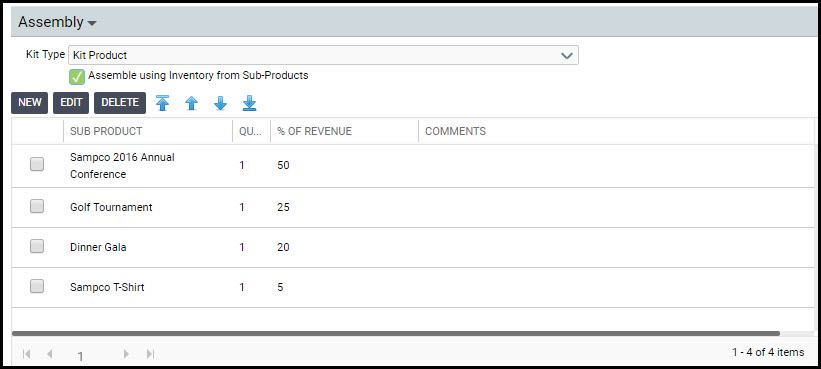About Assemblies, Kitting, and Inventory
Assemblies are used in the Aptify Inventory Control system to handle complex products that contain multiple parts. Each product may contain any number of component parts. The list of component parts that make up a product, along with their respective quantities, is referred to as an Assembly.
Assemblies are useful for both the physical manufacturing of products from sub-components, as well as for marketing promotions where new Products are simply bundles of other products.
There are two methods of handling assemblies of products in the Aptify Inventory Control system:
Dynamic component inventory is used when the product is not "assembled" until it is shipped and the true inventory levels are tracked only at the component levels.
Manually fabricated assemblies are used when products are actually being pre-built and inventories are being tracked both at the component level and at the assembly product level itself.
For accounting purposes, a prefabricated kit is treated just like a standard product. In other words, Aptify debits and credits the GL Accounts specified on the prefabricated kit's record. In contrast, a dynamic component kit debit and credits the GL Accounts for the specified sub-products, splitting the revenue entries among the sub-products based on the % of Revenue allocations.
At the order level, a prefabricated kit is treated just like a standard product. In other words, prefabricated kits are always added to an order as a top-level order line that cannot be expanded. In contrast, when a user adds a dynamic component kit to an order, Aptify adds the Expand Kits option to form so a user can display the sub-products that comprise the kit.
Dynamic Component Inventory
Dynamic inventory control is used for products that contain other products, but the assembly of the products does not occur until the goods are shipped to the customer. This method is primarily used for marketing bundles and promotions to offer special discounts and promotions to customers.
The benefit of dynamic component inventory is that Aptify Inventory Control automatically updates the inventory levels for the component products based on the quantity required by the assembly to make the product being sold.
To indicate that a product uses dynamic component inventory, select the Assemble using Inventory from Sub-Products option on the Assembly tab of the Products record. This tells the system to reduce inventory for the products that make up the assembled product rather than the assembled product inventory level.
For example:
Product A is a bundled product that contains two units of Product B and one unit of Product C. Additionally, there is no product inventory for Product A since it has been marked to Use Assembly Inventory. Product B has 100 units on hand and Product C has 50 units on hand.
Assembly of Product A when ordered:
Part | Units Each |
Product B | 2 |
Product C | 1 |
In the above example, if dynamic inventory is used for the product, a single unit sale of Product A results in the reduction of inventory from both Product B (2 units) and Product C (1 unit), simultaneously, due to the delegation of the inventory reductions through the assembly.
Product levels before an order for Product A is taken:
| Product B | Product C |
Quantity on Hand | 30 | 30 |
Quantity Available | 30 | 30 |
Quantity Reserved | 0 | 0 |
Quantity Shipped | 0 | 0 |
Product levels after an order for Product A is taken:
| Product B | Product C |
Quantity on Hand | 30 | 30 |
Quantity Available | 28 | 29 |
Quantity Reserved | 2 | 1 |
Quantity Shipped | 0 | 0 |
Prefabricated Assemblies
For products that are prefabricated, and therefore must carry their own inventory levels separate from the assembly/component parts, the Assemble using Inventory from Sub-Products option should remain unchecked. If left unchecked, Aptify Inventory Control adds or reduces inventory as needed on the product level itself, and the assembly parts are not directly affected. The assembly still builds and breaks-up products from or into component parts, but the logic to do so is separated from the individual inventory changes made for each order.
Related content
Copyright © 2014-2019 Aptify - Confidential and Proprietary
